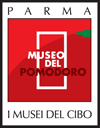Tomato History
From America to our tables
This is a success story which needs to be told, not out of boastful pride but because we can learn from history.
Why was the Tomato successful in Parma and not in other places?
That extraordinary melting pot of the agricultural and food industry which is our territory can boast many successes which are similar to each other, for example the breeding of cattle and the production of Parmigiano cheese, the breeding of pigs and the production of cured meats.
All these stories are linked by the solution found to the problem of ‘how’ to preserve a fresh yet perishable product, whether it be milk, pork meat or tomato. The geniality and practicality of the solution has determined the extraordinary “production chain” of our typical products.
Cooking is certainly “done” with flavours and aromas but it is also true that its history is marked by colour; the colour of the basic elements as well as colours “discovered” over the centuries. Whereas fish and meat have regularly been on men’s tables for thousands of years the same cannot be said of a surprising number of ingredients and condiments like, for example, sauces.
Up till the end of the renaissance period, all sauces, based on bread, vinegar wine and many spices were uniformly brown in colour. During the course of the XVII century, in the great kitchens of Versailles, the dishes of the Sun King were tinged with white thanks to the invention of béchamel and its many applications. Flavouring spaghetti in Naples was also white as they used grated Parmigiano (“like white cacio cheese on maccheroni” as people say) together with a generous sprinkling of black pepper, almost to imitate the great cone of Vesuvius.
Growing diffusion of the tomato and its increasing application in the kitchen from the beginning of the XIX century stimulated research into methods of conservation: the product is, in fact, seasonal reaching its maximum production peak in August. It was thus essential to find a way to preserve the fruit for as long as possible, for the entire year and above all in the non productive periods of the year.
Agricultural workers started boiling the chopped, de-seeded and skinned tomatoes for a long time until they obtained a dark and dense sauce which was then dried in the sun: this was the so called “black preserve”, produced in loaves and wrapped in oiled paper for protection. Just one small spoonful of this gave back the brilliant red colour to soups and other dishes in the cold winter months. Finally, the discovery of the Frenchman Appert allowed for the modern system of conservation and canning, initially in glass jars and later in tin cans.
At the end of the XIX century in the Province of Parma Carlo Rognoni (1829-1904), who was himself a farmer at Mamiana of Panocchia, was the first person to study the tomato and its cultivation, and experimented with the collaboration of a good farmer from Vigatto, Giuseppe Ferrari, finding the most suitable quality called Ladino of Panocchia. With this quality tomato Rognoni introduced full field cultivation and a two year agrarian rotation in association with maize and wheat in those fields which were well irrigated. The young plants were cultivated in sticked rows called porche with metal wire supports in the system called genovese which was used for many years until rendered obsolete by mechanical methods. Parallel experimentation was carried out at the land holding of the Technical Institute on the road to Mariano, today Via Bizzozero, and the economic outcome was periodically published by Rognoni. In 1874 Rognoni founded a company for the preparation of tomato preserve.


